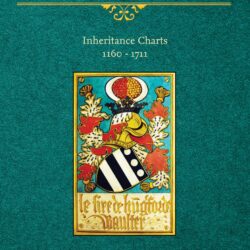
Our President, Lesley Abrahams (née Hungerford) [H.4a.1b.1c.1d/E.6.5a.1b.1c.1d]1 has spent much of the last decade researching the heraldic history of the Hungerford Family in England.
The launch of Hungerford Heraldry: Inheritance Charts 1160-1711 is set for 3 May 2021, and will coincide with the anniversary of the investiture of Walter, 1st Lord Hungerford on 3 May 1421, as a Knight of the Order of the Garter – exactly 600 years ago!
Lesley’s motivation to investigate the Heraldry in Salisbury Cathedral was to understand how it was devised and why it was there. Salisbury Cathedral is the location of a display of Hungerford heraldry, financed and installed by Jacob Pleydell-Bouverie, 2nd Earl of Radnor in 1779-1781.
The book Hungerford Heraldry includes Inheritance Charts which outline the ancestors of 47 Hungerford marriages, leading to the placement of the heraldry shields in the Cathedral as memorials to the Hungerford family.
Sir Walter was knighted in the reign of Henry IV, and became Member of Parliament for Wiltshire in 1400, serving also in 1404, 1407 and 1413-14. He was MP for Somerset in 1409. In 1413-14 he was elected as Speaker of the House of Commons. He also served as Sheriff for Wiltshire in 1405, and as Sheriff of Dorset & Somerset in 1414. As Baron Hungerford from 1436, he sat in the House of Lords until his death in 1449.
Sir Walter served with the English army in France in 1401, and then in 1415, he took 20 men-at-arms and 60 horse archers with King Henry V to France. He fought bravely at the Battle of Agincourt and later served with Henry V at the Siege of Rouen 1418, taking part in the peace negotiations in 1419.
As Knight of the Garter, Sir Walter was entitled to wear the Garter, and serve close to the monarch. His lands stretched at one time from east to west, requiring four stewards to administer them.
His stall plate was placed in St George’s Chapel, Windsor, on his pew until his death. Upon his death, a knight’s stall plates were removed to a wall nearby, and their banner returned to family members.
In his will Sir Walter styled himself “Lord of Hungerford, Heytesbury and Homet” (Normandy). He was buried in Salisbury Cathedral with his first wife Catherine Peverell in the Hungerford Chapel he had prepared. The Chapel, mortuary and commemoratory brasses were later removed during the renovations of Salisbury Cathedral by James Wyatt (architect), in 1779.

[box type=”note” style=”rounded” border=”full”]
Salisbury Cathedral is the home to the many sources for Hungerford Heraldry. One of HAFS founding members spent some time in Salisbury and surrounds some years ago, publishing an account of her visit in our Newsletter. That article is reproduced here for those interested in learning some more about the background to Lesley Abrahams’ book: see One Week in Salisbury, by Judith Fitz-Henry [E.8.3a.5b.1c], HAFS Newsletter 11 February 1996, pp 5-8.[/box]





Thanks Michael.